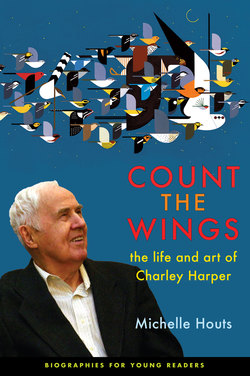Читать книгу Count the Wings - Michelle Houts - Страница 7
ОглавлениеAuthor’s Note
(As Close as I’ll Ever Get to) A Day with Charley Harper
IT’S MIDMORNING AS I wind my way down a narrow lane to the Harper home and studio. It’s the very beginning of a journey, and I’m excited and a little bit nervous, too. I had heard of Charley Harper, the artist. I had seen his bold, bright artwork on everything from art gallery walls to T-shirts. I’d prepared for my visit, reading everything I could find about the man. Still, I’m feeling a little uncertain. Am I in the right place? And then it comes into view—the Harper home and studio, tucked away on five acres of wooded terrain in the middle of a midcentury Cincinnati neighborhood. I get out of my car as Charley and Edie Harper’s only son, Brett, emerges with a smile and a wave.
The home and studio, built in 1958, are separate structures designed to blend with each other and with the surrounding hillside and beech forest. A boardwalk and overhead wisteria vines create an outdoor corridor between two sets of sliding glass doors. I think about how that two-way path flows between the house and studio—how it connected Charley’s family life with his work.
The studio’s two current rooms sit in stark contrast to one another. The newer of the two, a 1999 addition, is bright white with modern shelving, framed art, and a large, open work area. Charley’s signature red cardinal and ladybug appear prominently here.
When I venture up a single step and through a narrow doorway, I feel as if I’ve stepped back in time. This, the original 1958 room, was Charley’s space and it’s filled—floor to ceiling—with books and magazines, file cabinets, and chests of drawers. Allowing just enough room for me to squeeze through, a narrow path leads to the back of the small room, where Charley’s desk sits, untouched since his death in 2007. On the desk, the blue and black paints, sketches, and reference books are evidence of Charley’s last painting, Scary Scenario. The National Geographic Book of Mammals lies open, and a swimming polar bear stares up at me as it once stared up at Charley.
Back in the other room, Brett and the Harper Studio’s archivist and curator, Chip Doyle, have arranged family photographs on a table for me to look at and scan into my computer. They’ve asked for my wish list of the materials I need to begin my research of Charley’s life and work. It’s almost with embarrassment that I provide such a list, which includes childhood photographs, letters, grade cards, art school documents, wedding pictures, awards, and commendations. Is it too personal, what I’m asking? But Brett doesn’t blink an eye.
“Put me in, Coach,” Chip says. “What do you need?” I glance up at Brett to see if he’s going to answer, but Chip is looking at me. They pull up a stool for me with an old green field jacket hanging over the back and we get to work. Brett and Chip dig through boxes and albums as I scan articles, documents, and photographs.
“Look at this!” and “Now here’s something I’ve never seen!” are two phrases often repeated as they open more boxes and uncover artifacts long forgotten. Charley’s possessions, still strewn about the studio as if he had been there yesterday, are treated with a unique combination of respect and practicality. That field jacket on the back of my stool, Chip mentions casually, was Charley’s. It’s his U.S. Army jacket from World War II, bearing the Timberwolf insignia of the 104th Infantry Division. A treasured possession, it hasn’t left the stool for eight years. And yet, if I said I was cold, I’m pretty sure someone would say, “There’s a jacket on the back of your stool. Put it on.”
Hours pass in a heartbeat. Picture by picture, piece by piece, Charley’s life unfolds before my eyes. We’ve only scratched the surface. There’s more to do, more to see, many more questions to ask. But the artist who was a mystery to me is now a real person. His passions and dreams are becoming clearer; his story is beginning to form in my head.
The fact that Charley is becoming more real to me is both a relief and a terrifying realization. As I pack up my work, say goodbye until next time, and get into my car, my head swims with doubts. Will I be able to do this man justice in telling his story? How do I capture the essence of this gentle soul, so in tune with nature and with people? Will I be able to connect today’s youth with this artist whose work they’ve likely seen but whose name they may not know?
I maneuver my car around on the only flat ground on the rolling property, then point it out the long, wooded lane toward the surrounding neighborhood. It’s late afternoon, and the sun hasn’t made much of an appearance all day. The October landscape is brightened by the yellow and gold leaves that defy the wind and refuse to fall. November is just around the corner.
The driveway is so narrow that small branches brush my car as I pass. I round the bend, still feeling the weight of my own doubt. My eyes shift suddenly to the left. A flash of red. A dip and dart. And he’s gone. He had been swift, for sure, but he’d lingered just long enough to let me know he was there. A cardinal. I smile, then laugh out loud.
Charley Harper’s cardinal.
All my misgivings fade with the sound of my own laughter. I’m ready to do this. I’m ready to tell you about Charley Harper, the artist.
Charley placed this sign, a memento from a visit to a local elementary school, on his studio door.
Photo by the author
